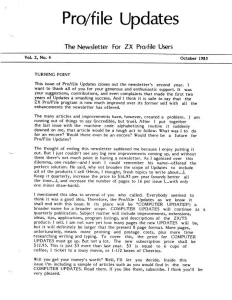| How to Connect Your TS/ZX to a Monitor – Easily |
Anyone who has stared at those funny little moving marks or lines of distortion on TV displays, anyone who would like to enjoy a crystal clear image without the annoyance of RF interference and having to carefully adjust the TV set’s fine tuning, or arrange cables just so, anyone who thinks a quality monitor would |
Timex/Sinclair 1000 |
| Introducing the Experimentor's Universal Input/Output Port |
Some of you may remember that a LONG time ago, I said I wanted to offer a simple parallel port and use it as the basis of a series of programs designed to show computer hobbyists the what’s, why’s and wherefore’s of “Programming for Ports”. My plan was (and still is) to provide many interesting |
Timex/Sinclair 1000, Timex/Sinclair 2068 |
| Port Project #1: Data Communications Between Two Computers |
This first project gives you the basis of a very useful application involving I/O ports–communicating between two computers. |
Timex/Sinclair 1000, Timex/Sinclair 2068 |
| Pro/File Plus Cassette Clarification |
Last issue I stated that cassettes of “ZX” which contained many enhancements published in Updates was available. Apparently it was not clear to many that the biggest enhancement of all, the machine code alphabetizing routine featured in the last issue, was included on this tape. |
Timex/Sinclair 1000 |
| Pro/File Pokes for the Byte-Back Centronics Printer I/F |
Here is the Parallel I/F modification for the new Byte-Back interface. |
Timex/Sinclair 1000 |
| Turning Point |
This issue of Pro/file Updates closes out the newsletter’s second year. I want to thank all of you for your generous and enthusiastic support. It was your suggestions, contributions, and even complaints that made the first two years of Updates a smashing success. And I think it is safe to say that the ZX Pro/File |
|
| Z80-B, Bent EPROMs, ROM-PAK Notes |
Please note that the ROMPAK edition of ZX Pro/File has many program lines (all the DIM lines plus 9960/9970) which can be deleted after the program is transferred from eprom to memory and before the program is saved to tape. This saved memory can be used to enlarge DS or add modifications. |
Timex/Sinclair 1000 |
